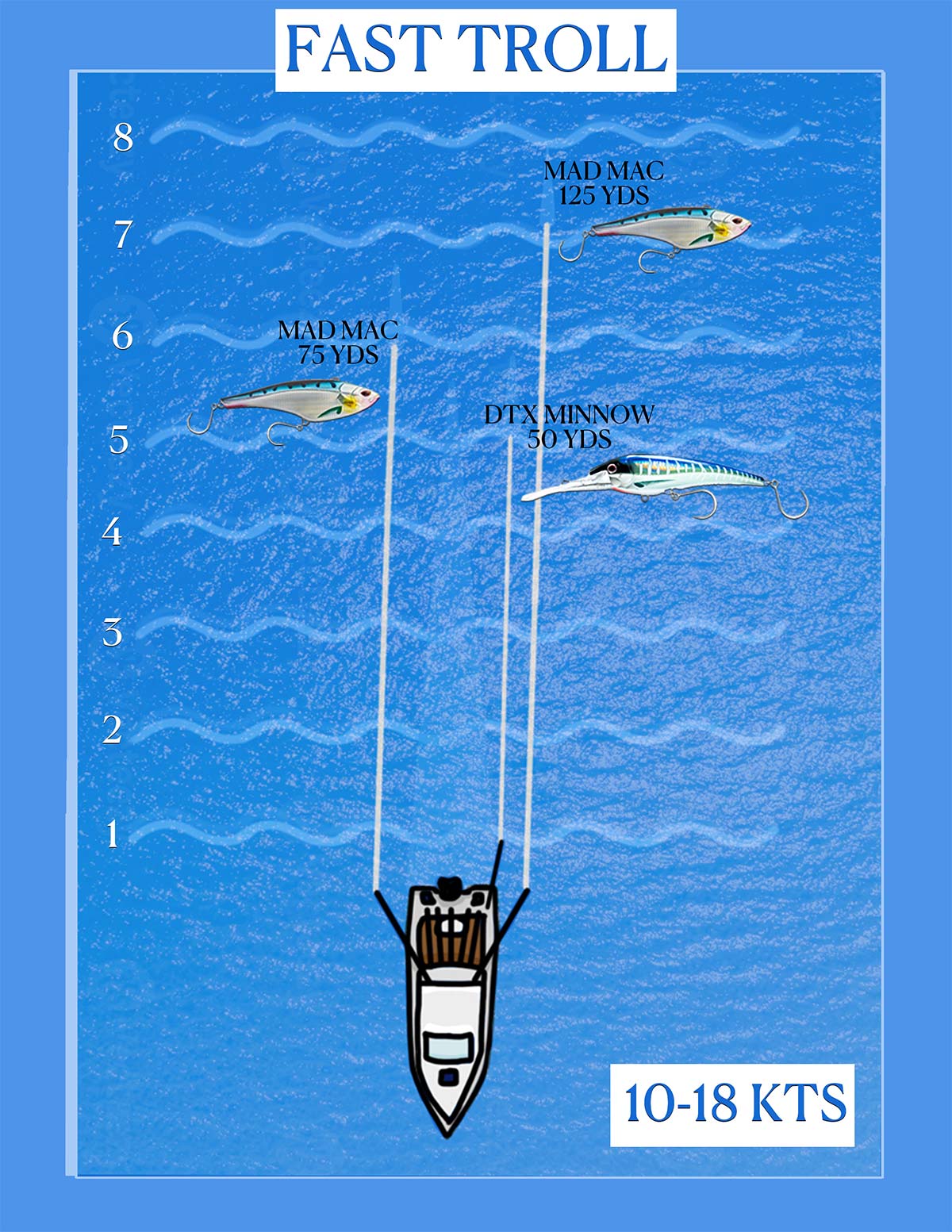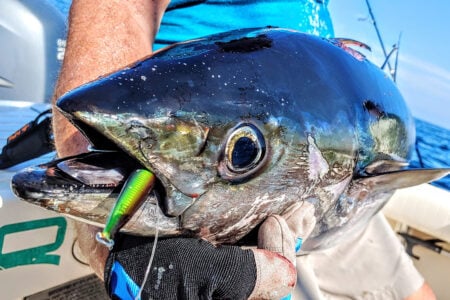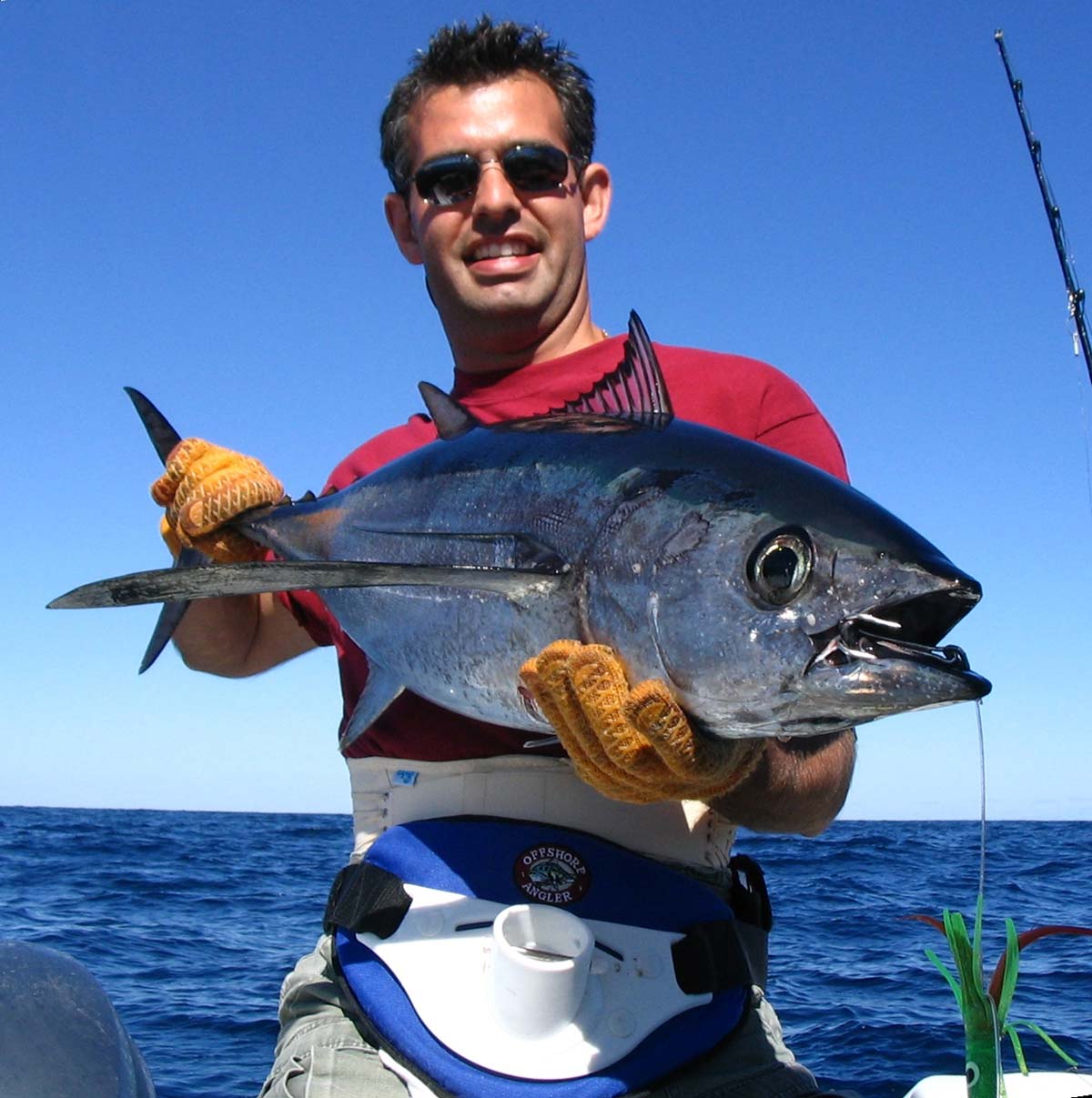
One of the most exciting moments in coastal saltwater fishing is the banshee wail made by a trolling reel under duress when a hungry tuna grabs a bait or lure dancing in your boat’s wake and takes off for the horizon at warp speed. Few moments can top this for instant heart-pumping adrenaline. And it’s why tuna trolling is often described as hours of boredom punctuated by moments of madness.
Man has been fishing for tuna for millennia. But ever since the dawn of the industrial age and mechanical propulsion on seaworthy craft, anglers evolved and started dragging baits behind the boat in an effort to find and catch tuna more consistently. The Greeks and Romans were boating bluefins in the Mediterranean Sea over 2,000 years ago, as chronicled by philosophical writers Aristotle and Pliny the Elder. According to a 2021 report from The Oregon Department of Fish and Wildlife, “Commercial harvest of hook-and-line caught, or troll-caught albacore tuna has occurred off Oregon since 1929 when the fishery expanded north from the traditional Southern California grounds.”
There are records of California anglers trolling for tuna in the early 1900s. It was documented that Dr. Charles F. Holder, founder of the Catalina Tuna Club, caught the very first tuna (183 pounds) on rod and reel in 1898 and the earliest tuna trolling lures were cast out of glazed pottery.
With long-range fuel tanks, big screen electronics and reliable four-stroke outboard powerplants, boats as small as 20 feet in length have been participating in the near offshore tuna trolling action over the past few season. The one caveat when seeking tuna in coastal waters via downsized platforms is the need to pick weather windows carefully and wait for the fish to come within 25 to 30 miles off the beach. The bigger boats can handle rough seas and longer distances with more comfort and safety and usually have the room and range to venture anywhere from 30 to100 miles offshore to find the action.
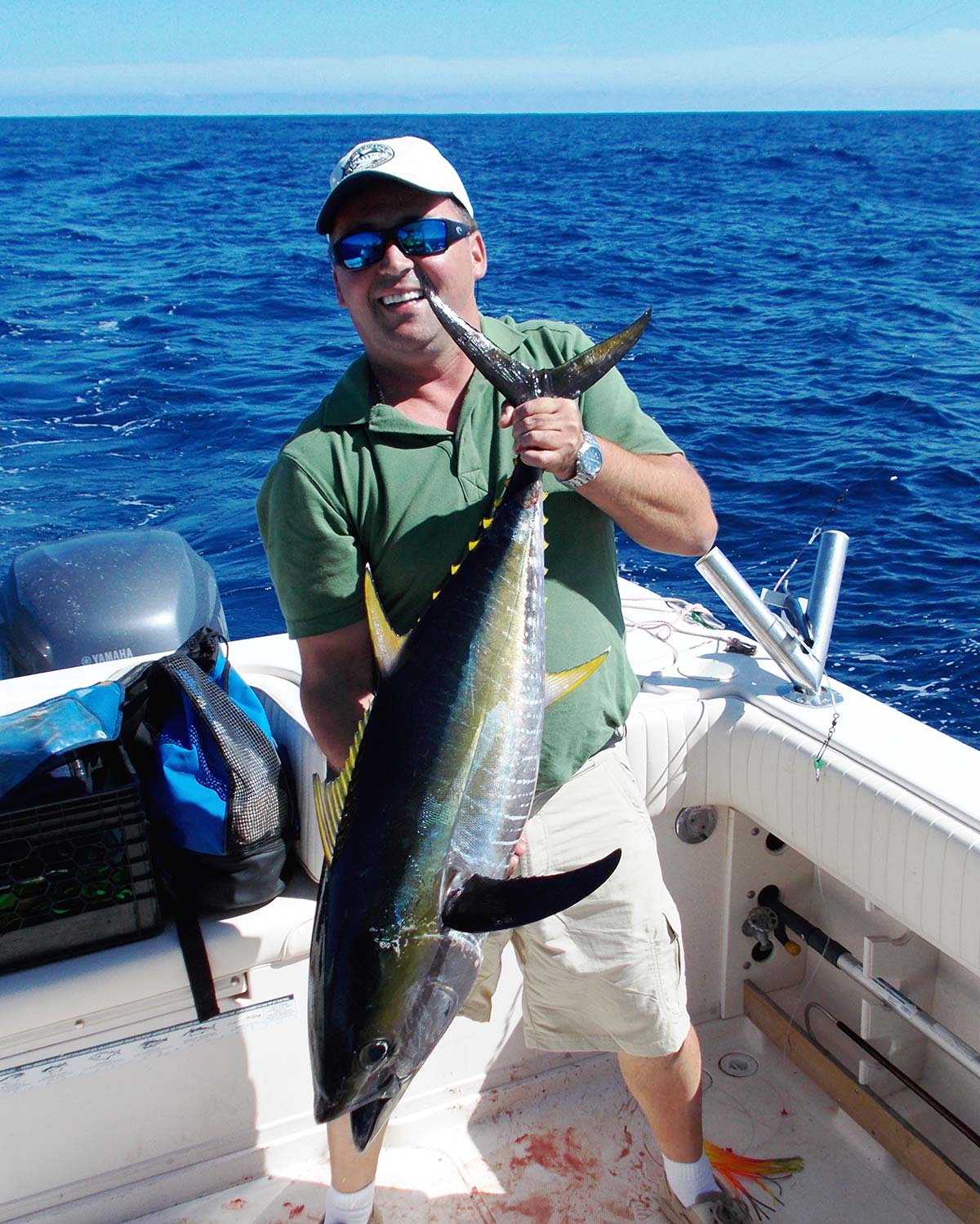
Work The Wake
When you take a step back and consider the five primary/diverse methods of tuna tangling (trolling, jigging, sight casting/surface popping, riding heard on the bunker schools inshore with live bait and chunking/dead bait fishing offshore), trolling allows you to cover a lot more ocean in search of your quarry. This method enables anglers to make repetitive passes over productive areas once you find the fish and mark the hits on your chart plotter for reference.
Trolling also lets you to follow the tuna schools as they move around. Chugging along at 5 to 8 knots, depending on sea conditions, gives you the leverage to work the draggers in the usual 30- to 40-fathom areas, where they create an active chum slick for you to troll over in your search for fish. Dragging baits and lures in your wake gives you the flexibility to work the edges of temperature breaks, wrecks, canyon edges and lobster pot buoys, which are known hangouts for foraging tuna species in their constant movement and never-ending search for forage.
When I look back at my 40+ years of owning a total of 18 coastal sport fishing boats, only one of these was over 25 feet in length and that was my beloved twin-outboard powered 27 Phoenix Express that I ran for 10 seasons. All 17 of the other craft were 25 feet in length or less. I have literally caught thousands of tuna while trolling from small boats and this is my specialty.
One of the secrets to successful tuna trolling from whatever boat you run – but especially critical for smaller boats – is to make the maximum amount of noise in your wake. Offshore predators have been conditioned over the past 100 years to be attracted to a vessel’s water turbulence when underway, since baitfish typically try to hide in the agitated water (aka “wash”) when transiting the open ocean as a form of defense and self-preservation. Dragging baits and lures in your wake at the typical trolling speeds of 5 to 8 knots creates the illusion that pods of terrified baitfish are swimming in and out of the white water that’s created by your prop and chine wash.
The more stuff you drag aft, the more noise you create, with lures and baits swimming in and out of the clean lure channels created by your vessel’s hull. This in turn sets up the con, where you are presenting “targets of opportunity” for marauding schools of tuna that might be foraging on the bottom, at mid-depths or somewhere above the thermocline. Your boat’s wake brings them in and the swarm of lures dragging aft hopefully matches the local hatch and put them in a feeding mood.
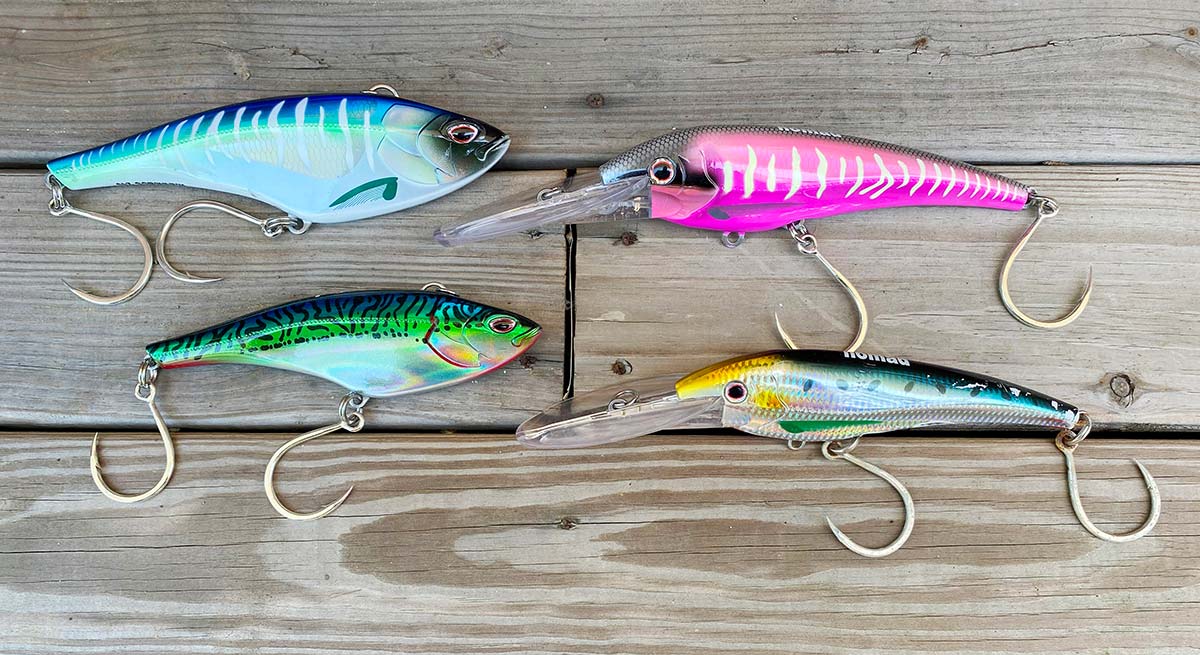
Small Boat (20 to 25 feet) Trolling Patterns – No Outriggers
As I frequently write here in The Fisherman, there are enough rodholders onboard your boat! No matter how many are there, you always seem to want one more in this place or that. That said, if you want to be a small boat tuna troller, you’ll need to set up your vessel to be equipped with at least three flush-mount rodholders in each gunwale’s covering board, with an equal or greater number of vertical rodholders in whatever leaning post/rocket launcher, T-top, hardtop or rail-mounts that are onboard. These are a must, since you need somewhere to stow the rods when clearing the decks after a strike. A six-pack of lures or baits trolling in your wake will make a lot of noise, but seven is even better.
My EdgeWater 228 CC powered by a single Mercury 250HP V-8 outboard trolls seven rods on a regular basis, and has caught its weight in tuna by a factor of three in her 8 years under my stewardship. This boat creates a moderately quiet wake with clear lure channels and a nice “hum” that brings them in from all around the neighborhood. Historically, I haven’t found the need for outriggers on my smaller boats, but love those center riggers whenever I can install them for dragging the long offering up and out of the way for zero tangles.
| FAST TROLLING |
| Yet another fishing innovation to emanate from the left coast is the fast troll tuna spread that has been extremely effective for Southern California anglers the past two seasons. This technique requires that you drop back a pair of Nomad’s 200 or 240-series Madmacs at staggered distances anywhere from 75 to 150 yards behind the boat and then “fast troll” these diving plugs near the edges of foraging schools of bluefin tuna. Accessory hardware like outriggers and/or flatline clips are not required and successful boats simply stick the rods in the corner rodholders and hold on for violent strikes. While straight butt trolling, standup or Cali jigging rods will do the job, bent butt outfits will lower the rod tip’s effective height above the waterline and will allow these shallow diving plugs to bore a bit deeper down into the water column.
This tuna technique will work with a variety of boat types from 21-foot center consoles to 60-foot sportfishermen. I have talked to some seasoned Cali anglers at the winter boat shows and many will add a deep-diver to the mix, like a Nomad 165, 200 or 220 series DTX minnow, depending on the size of the fish. Larger, beamier boats can add a pair of these DTXs with minimal fear of tangling them. The Madmacs are set out first, with the appropriate drop back to keep them submerged and free from tangled crossovers when making turns. The DTX minnow is then set approximately 50 yards aft of the transom, diving down into clear water under the wake wash so that tuna can get a really good look at it. The 15- to 20-knot speeds will force the tunas to react quickly, or their fleeting “meal” will get away. |
My typical hardware array when it’s time to troll consists of rodriggers that hold the rods 90 degrees out from my first pair of 0-degree angle rodholders. These create an extended “outrigger spread” of sorts, without any of the hassles, maintenance or cost. The middle set of 30-degree angle rodholders are toed out approximately 35 to 45 degrees from the boat’s centerline and the aft set of 30-degree angle flush rodholders are parallel to the keel, facing straight back in the wake.
Once the requisite rodholders are in place and you are setting up for the troll in a likely spot, it’s time to make a racket that will hopefully ring the dinner bell. My historical small boat “go-to” flight pattern that has achieved excellent results calls for a deep-diving swimming plug like a Braid Marauder or Little Speedy set up on the second wake with a matching diver, small jet-head or a daisy chain on the opposite side. Since the closer the lures are to the transom, the more they have a tendency to fly out of the water due to the wake’s turbulence; that’s why I will always attach these to flatline clips like AFTCO Roller Trollers or RUPP clips.
The middle rodholders run a pair of squid spreader bars straight off the rod tip, with the size and color du-jour set back in the third or fourth wake, depending on water conditions and where the hits are coming. Moving to the forward set of rodholders, the rodrigger setups are sent back to the fifth or sixth waves aft and are running either a bird/Psychobead or bird/ballyhoo combo, where the birds clearly identify the location to help prevent tangles when making turns and also provided an added allure to the package. I’ll then run a seventh rod off the T-top’s rocket launcher and set that “way back” in the vessel’s eighth or ninth wave, anywhere from 100 to 125 yards behind the boat. The usual candidate for this position is a large Japanese bird painted over from its original red coloration to a black and white hue that resembles a Shearwater diving in for a snack. Trailing 8 feet aft of that is either a rainbow or green Psychobead and there are days when this shotgun lure gets 90% of the hits.
Two seasons ago, I eschewed the rodriggers in the forward rodholders and instead employed Sterling’s Wide Tracker spreader bars, which steer outward about 35 to 40 degrees from the boat and work the clean water in front of the wake. This pair of squid bars is then complemented by a second pair that is run directly off the rod tips from the aft set of rodholders. The middle pair of rodholders that are angled somewhat outboard are now rigged with either Nomad Madmacs or DTX Minnows, with these swimming directly under and between the twin spreader bars on either side. I still run old faithful, the big bird and Green Machine combo in the long position from a T-top rodholder. This is a deadly evolution of my vessel’s preferred flight pattern.
This season I plan on adding yet another experimental trolling pattern to my EdgeWater’s arsenal. Taking a page out of the west coast San Diego tuna trolling playbook, I’ll be running a twin Madmac, twin DTX Minnow high speed setup on occasion, where trolling speeds will range anywhere from 10 to 18 knots. I have seen enough YouTube videos of high-speed Madmacs simply slaying migrating bluefin tuna to know that this same technique might have equal potential on the east coast.
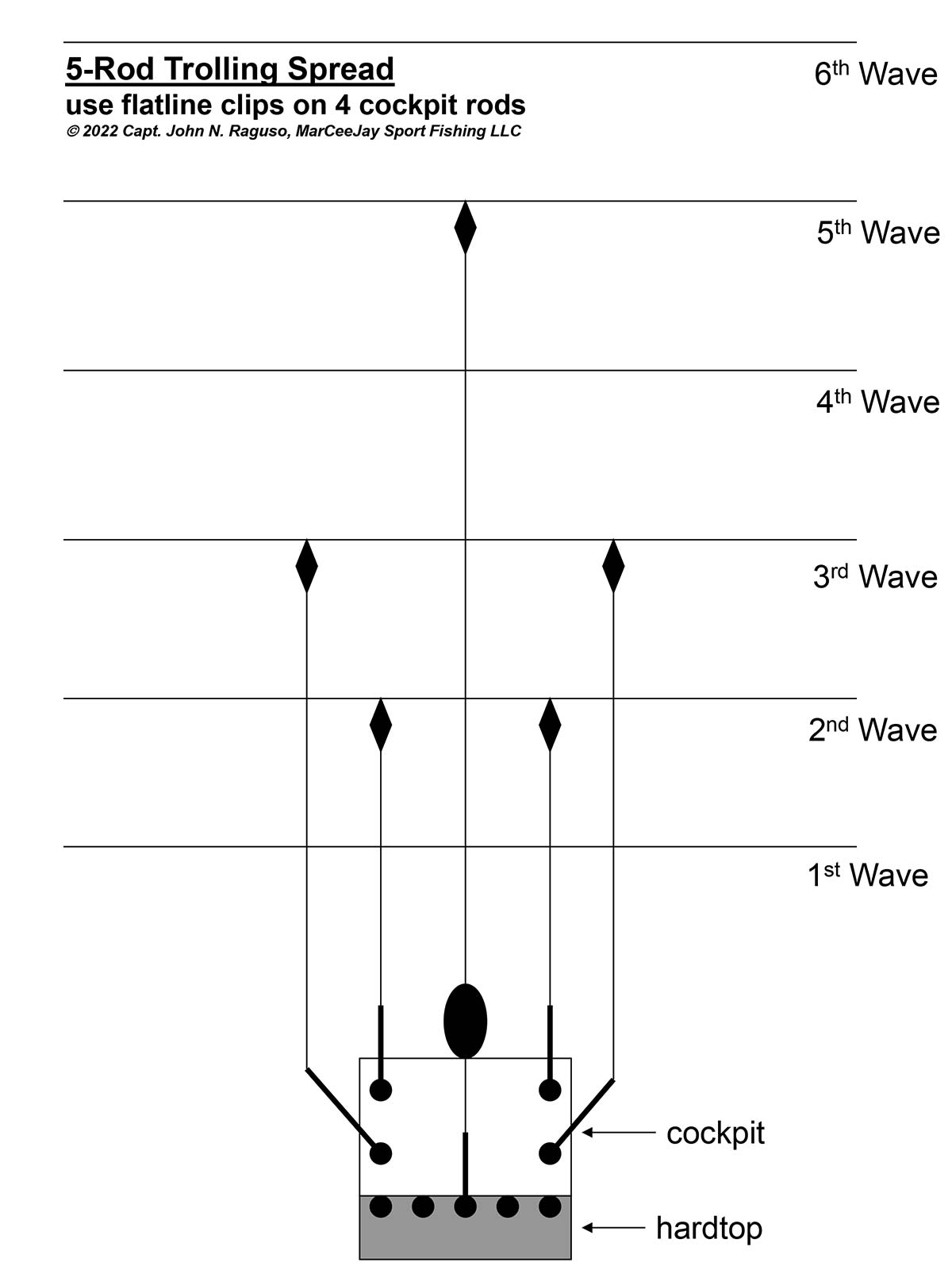
Mid-Sized Boat (26 to 31 feet) Trolling Patterns – With Outriggers
Everything that we mentioned in the small boat section about lure types and wake positions carries over to the mid-sized tuna trollers, but there’s more. The extended lengths and beams of this group creates additional space for an increased array of gunwale-mount and vertical rodholders, plus outriggers make total sense on these platforms due to the added room and layout. Going with 15- to 16-foot outrigger poles affords a wider flight pattern of lures in the wake and more surface commotion usually means that you can attract a crowd from a greater distance.
Some anglers will rig dual halyards (aka outrigger lines) and clips for their outrigger setups, creating the classic long rigger and short rigger approach for each side. But be advised that additional baits trolled in the wake create the need for an equal number of vertical rodholders on the tower legs or hardtop to stow them out of the way during a partial cover up, where the tuna hit some of the rods, but not all. It’s possible to run 9 or 10 rigs aft on a mid-sized sportfisher, with a six-pack of spreader bars and complementing ballyhoo or daisy chains in the mix. Any pattern that you can create to keep the baits in line (over and under) on the turns and prevent tangles when the lines go off is fair game and this represents the “art” side of offshore fishing.
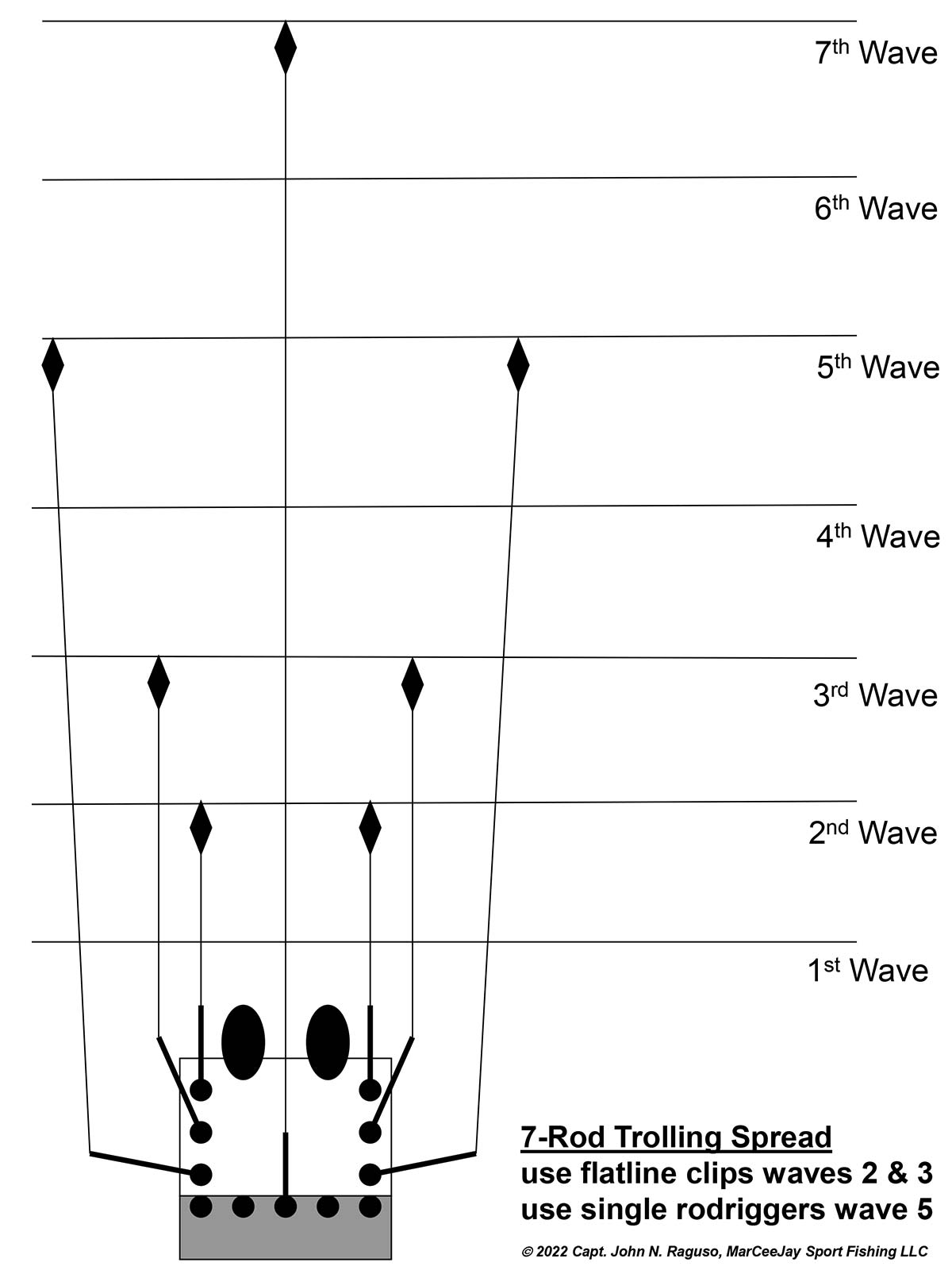
Larger Boat (32 to 45 feet) Trolling Patterns – With Outriggers & Center Rigger
Bigger can frequently be better when it comes to trolling setups, and larger boats have more room for the requisite elements to make the trolling game work. Three of the obvious additions that bigger boats bring to the trolling plan are the ability to mount a center cockpit leaning post station to add four to six rodholders for either trolling or stowage; longer outrigger poles in the 18- to 21-foot range that enable a triple halyard setup; plus the addition of a center rigger to keep the long shotgun rod above the fray and safe from any tangles.
Larger cockpits typically translate to higher gunwales, increased elbow room and enough dancing space for a quartet of anglers to deal with a cover up and not trip over each other during the fight. I’ve been on boats in this size class with wider 11- to 14-foot beams that could troll a dozen rods without a hiccup. Sure, you needed at least a trio of experienced crew members to set the entire process in motion with the correct sequence to avoid dreaded tangles. However, it’s done all the time and 10 to 12 squid bars, daisy chains and skirted ballyhoo will make quite the ruckus in your wake.
To expound on the variety of trolling patterns for different sized vessels, you’d need a large illustrated book to cover it all; but hopefully we’ve touched on a few of the hot buttons to get you in the game and thinking like a tuna. Keep on experimenting with lure and bait positions in the wake, colors, speeds and the types of offerings that you are dragging aft. Listen to the VHF to eavesdrop on what folks are doing on that particular day, make the necessary adjustments in your trolling plan to adapt and be safe out there.

